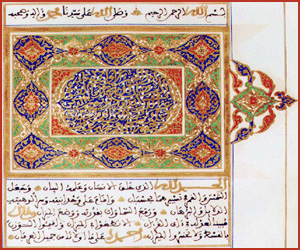LearningAbout and From
Islamic Chemistry:
The Western
interest in, and knowledge of, Muslim chemistry was intensified
by the 12th century translations from Arabic into
Latin
carried
out in
Islamic pharmacology with its chemical
content received a good deal of interest on the part of European
translators. A treatise by Al-Maridini of
The medical aspects of Muslim chemistry
have recently attracted the interest of both Meyerhof[7]
and Levey.[8]
The main subjects of such Muslim pharmacy, according to Levey,
are:
1) Medical formularies which include many
kinds of compound drugs, pills, pastilles, powders, syrups,
oils, lotions, toothpastes...
2) Books on poisons.
3) Synonymatic: treatises, in which are
found lists of simples usually in alphabetical order to help the
reader to identify the drug in other languages.
4) Tabular, synoptic texts, whereby long
texts are turned into tabular work for quick usage, and
abstracts made of some treatises for the same purpose.
5) Lists of materia medica which include
therapeutic considerations and opinions of various writers on
the subject, preparations of the drugs and descriptions..
6) Substitute drugs in case one drug for
whatever reason was not available, a substitute was provided.
7) Works on medical specialities
available either as separate treatises or as sections of large
encyclopaedias of medicine.[9]
Many aspects of Islamic chemistry have
been dealt with by Holmyard, Kraus, and above all Ruska. Much of
such material, however, is only available in German.[10]
Despite such focus, there is still no comprehensive work on
Islamic chemistry by any single author. Other than lack of
interest amongst today’s scholarship, in particular, practical
obstacles stand in the way of this task.
Western scholars, as De Vaux
points out, are hampered
by the fact that many aspects of Islamic chemistry, notably
industrial technology, remain too technical for the Arabist to
comprehend.[11]
For the chemist, it will be Arabic (the language) that will be
hard to comprehend. Another problem is difficult access to
manuscripts; Sherwood Taylor points to
hundreds of Islamic works on chemistry, and only very few are
translated into a European tongue.[12]
The poor translation of
manuscripts already
‘edited or translated’ also stands in the way. Apart from Jabir,
and al-Razi, the contribution of Muslim chemists has been
neglected. Apart from a few extracts on al-Majriti, little is
known of the Muslim-Spanish chemical tradition. Yet, as Holmyard
insists, the study of Muslim chemistry in
[1]
See. G. Sarton: Introduction; op cit; vol 2 for
translations of Muslim science into Latin
and other
languages.
[2]
J. Ruska: Das Buch; op cit; mentioned in R.
Halleux: The Reception of Arabic Alchemy in the West, in
the Encyclopaedia (Rashed ed) op cit, pp 886-902,
at p. 892.
[3]
R. Halleux: The Reception, op cit, p. 892.
[4] A. Mieli: La Science Arabe; op cit; p.157
[5]
In H. Ritter, J. Ruska, F.Sarre, R. Winderlich:
Orientalische Steinbucher und persische fayence-Technik (
[6]
M. Meyerhof: Science and medicine, in The Legacy of
Islam, (T. Arnold and A. Guillaume); pp 311-55; at
pp 331-2.
[7] M. Meyerhof: ‘Esquisse d'histoire de la pharmacologie et de la botanique
chez les Musulmans d'Espagne,' al-Andalus 3
(1935), pp. 1-41.
[8]
M. Levey:
Early Arabic Pharmacology;
op cit.
[9]
Ibid; pp
68-70.
-P. Kraus: Jabir Ibn Hayyan; Textes choisis
(Paris, Cairo
, 1935).
-J. Ruska: ‘Al-Rasi; op cit.
-J. Ruska: ‘Die Alchemie des Avicenna; op cit.
-J. Ruska: ‘Die Alchemie ar-Razi's'; op cit.
-J. Ruska: Das Buch der Alaune; op cit.
[11]Carra De Vaux: Les Penseurs; op cit; p. 391.
[12]
F. Sherwood Taylor: A Short History; op cit;
p.81.
[13]
E.J. Holmyard: Maslama; op cit; p. 293. |
